Keywords |
| CBR, RWA and CPU, different topologies. |
INTRODUCTION |
| Wavelength-Division Multiplexing (WDM) in optical fiber networks has been rapidly gaining acceptance as a means to
handle the ever-increasing bandwidth demands of network users. In a wavelength-routed WDM network, end users
communicate with one another via all-optical WDM channels, which are referred to as light paths. A light path is used to
support a connection in a wavelength-routed WDM network, and it may span multiple fiber links. In the absence
wavelength on all the fiber links through which it traverses. RWA needs to find a path and assign the same wavelength to
every link along the path. This is known as the wavelength continuity constraint. This means there are cases in which
connections cannot be established even if every link along the path has wavelengths available. |
| A new technology is needed to support for the huge bandwidth needs. Optical fiber offers much higher bandwidth than
conventional copper cables. A single fiber has a potential bandwidth on the order of 50THz. Blocking probability has been
one of the key performance indexes in the design of wavelength-routed all-optical WDM networks. Existing research has
demonstrated that an effective Routing and Wavelength Assignment (RWA) algorithm and wavelength conversion are two
primary vehicles for improving the blocking performance. A wavelength-routed all-optical WDM network comprises
optical wavelength routing nodes (i.e., wavelength routers) interconnected by optical fiber links. A lightpath has to be
established before the communication between any two wavelength routers. Lightpath connection requests arrive over time
and each lightpath may have a random holding period. These lightpaths need to be set up dynamically by determining a
route across the network connecting the source to the destination, and allocating a free wavelength channel on each fiber link along the chosen route. Wavelength conversion can eliminate the wavelength continuity constraint and thus improve
the blocking performance. |
LITERATURE SURVEY |
| Chunyong Yang, Shaoping[2] shows that performance analysis of four classical topologies networks from the perspective of
blocking probability, average hop count, average packet delay and link utilization has been carried out depending on
wavelength conversion factor. In general, though the star topology performs the best on blocking probability, average hop
count and average packet delay, it is unfavorable on link utilization. Furthermore, wavelength conversion is not ideal for the
star topology. So it is turned out to be an expensive topology. However, the ring topology network is the cost-optimal one if
the appropriate wavelength conversion capability in network is to be considered. |
| Randhawa, Rajneesh; Kaler, R. S.; Singal, Anuj[4]gives the performance evaluation of first-fit, random, most-used and
wavelength conversion algorithms in WDM optical ring network are being proposed. The blocking probability of various
algorithms has been compared. The blocking probability is maximum for first fit algorithm and least for wavelength
conversion algorithm nearer to 0.01 and 0.0025 respectively. So the performance of the wavelength conversion algorithms
is best but there is burden of using expensive hardware. Without the need of wavelength-convertor, the most-used
algorithm performs better than the random and first-fit algorithms. These approaches are very effective for the minimization
of blocking probability of optical WDM networks. |
ROUTING AND WAVELENGTH ASSIGNMENT ALGORITHM |
| RWA is a fundamental problem in the engineering, control, and design of All-Optical Networks, and arises in most network
design applications, including traffic grooming, survivability design, and traffic scheduling. Internet is formed by collection
of topologies. Different topologies exhibit different performance parameters like traffic congestion, delay, packet loss and
cost. Traffic congestion is an important parameter which has to be reduced for All-Optical Network in different
topologies.RWA of lightpaths in optical networks is usually done in two steps. The first step tries to find a route between
the node pair, and the second assigns wavelengths for links of the route. The literature suggests different solutions, with
separate or simultaneous handling of these steps. One approach is to route all connections first, and then assign wavelengths
to them as a separate step. Another approach is to combine the steps so that routing is tied to a particular wavelength. This
latter approach is typically accomplished by starting with a particular wavelength and reducing the network topology to
only those links on which this wavelength is available. |
Routing algorithm |
| For the routing algorithm, there are three basic approaches that can be found in the literature: fixed routing, fixed-alternate
routing and adaptive routing. Among these approaches, fixed routing is the simplest while adaptive routing yields the best
performance. Alternate routing offers a trade-off between complexity and performance. We briefly discuss fixed routing
approaches later in this work. |
Fixed routing |
| The most straightforward approach to routing a connection is to always choose the same fixed route for a given sourcedestination
pair. One example of such an approach is fixed shortest-path routing. The shortest-path route for each sourcedestination
pair is calculated off-line using standard shortest-path algorithms, such as Dijkstra’s algorithm and any
connection between the specified pair of nodes is established using the pre-determined route. This approach to routing
connections is very simple. However, the disadvantage of such an approach is that, if resources (wavelengths) along the
path are tied up, it can potentially lead to high blocking probabilities in the dynamic case, or may result in a large number of
wavelengths being used in the static case. Also, fixed routing may be unable to handle fault situations in which one or more
links in the network fail. To handle link faults, the routing scheme must either consider alternate paths to the destination, or
must be able to find the route dynamically. |
Static RWA models |
| All the light paths that are to be set up in the network are known. The objective is typically to accommodate the demand
while minimizing the number of wavelengths used on all links. |
Dynamic setting |
| The light path requests between source destination pairs arrive one by one. A typical objective is to minimize the call
blocking probability or the total number of blocked calls over a given period of time. On the contrary, dynamic routing
algorithms are good candidates for traffic engineering and generally they can improve the blocking performance
significantly. |
Goal of routing and wavelength assignment algorithm |
| • To analyze the performance of same algorithm in different topologies, so we can use it for specific application. |
| • Satisfying the bandwidth, delay and throughput requirement for every admitted connection. |
| • Reduce call blocking ratio. |
FIRST FIT ALGORITHM |
| Choose the lowest indexed wavelength from list of free wavelength and assign it to the connection request. When the
request is completed the wavelength is added back to the free wavelength set. |
First-Fit wavelength assignment |
| First-fit does not require global knowledge about the network. No storage is needed to keep the network states and no
communication overhead is needed. The computational overhead is small and the complexity is low. Moreover, the
performance in terms of blocking probability and fairness is among the best. |
| Therefore, first-fit is preferred in practice although the performance analysis of optical WDM networks is studied
extensively that there is less work for analyzing the blocking performance of first-fit scheme. In this scheme, all
wavelengths are numbered. When searching for available wavelengths, a lower numbered wavelength is considered before
a higher-numbered wavelength. |
| The first available wavelength is then selected. This scheme requires no global information. Compared to Random
wavelength assignment, the computation cost of this scheme is lower because there is no need to search the entire
wavelength space for each route. |
TOPOLOGIES USED FOR COMPARING BLOCKING PROBABILITY |
| 1. Random |
| 2. Star |
| 3. Ring |
| 4. Tree |
Network stimulation |
| We present stimulation scenario and results to illustrate the performance of topologies. The topology scenario random, star
ring, tree presented in fig 1, 2, 3, and 4 respectively. |
PROBLEM FORMATION |
| As the WDM technology matures and the demand for bandwidth increases, dynamic provisioning of lightpaths at the WDM
layer becomes an important and challenging problem. Any distributed algorithm for routing dynamic traffic should be
simple, efficient, and also scalable. Most of the multimedia and real-time application requires specific quality of service
(QoS), hence it is important that the routing algorithm should provide lightpaths which satisfy the required QoS. Our
proposed algorithm also measures the performance evaluation considering call blocking ratio and simulation time.
Next Generation WDM based Network basically focuses on the Routing and Wavelength Assignment (RWA) problem in
wavelength-routed optical WDM networks. Most of the attention is devoted to such networks operating under the
Wavelength- continuity constraints, in which light paths are set up for connection request between node pairs, and a single
light path must occupy the same Wavelength on all of the links that it spans. |
| In Different topologies exhibit different performance parameters like traffic congestion, delay, packet loss and cost. Traffic
congestion is an important parameter which has to be reduced for All-Optical Network in different topologies. Setting up a light path, a route must be selected and a Wavelength must be assigned to the light path. If no Wavelength is available for
this light path on the selected route, then the connection request is blocked. In our proposed work Wavelength is assigned
dynamically depending on the bandwidth factor. |
| We examine the RWA problem and review various routing approaches and Wavelength assignment approaches proposed in
the literature. Finally we have proposed a new RWA algorithm, which works well under dynamic traffic by checking the
performance of call blocking ratio at constant number of calls. And we demonstrated its performance through simulation. |
PROBLEM STATEMENT |
| The difference in blocking probabilities among random, Ring, star, tree topology is depicted. By observing the
performance evaluation parameter such as blocking probability ratio and stimulation time star topology performs best on
blocking Probability and takes less simulation time as compared to other topologies. |
| Performance evaluation parameter: |
| Blocking probability ratio = (total calls – successful calls) /total calls |
| Simulation time = CPU time |
| Wavelength chosen is 50 per link |
| Number of calls = 100 |
SIMULATION RESULTS |
| Below figures 5,7,9 and 11 shows the performance blocking probability and figures 6,8,10 and 12 shows the performance
of simulation time in random, ring, star, tree topology respectively. |
CONCLUSION |
| By comparing the values of different topologies on the basis of CALL BLOCKING RATIO and CPU time (sec), for
Random topology CBR is 24% and CPU time is 0.6 sec, Star CBR is 7% and CPU time is 0.5sec, Ring 47% and CPU time
is 0.65sec, Tree topology 50% and CPU time is 0.7 sec.It is observed that the star topology performs best on blocking
Probability and takes less simulation time as compared to other topologies. |
Tables at a glance |
 |
| Table 1 |
|
Figures at a glance |
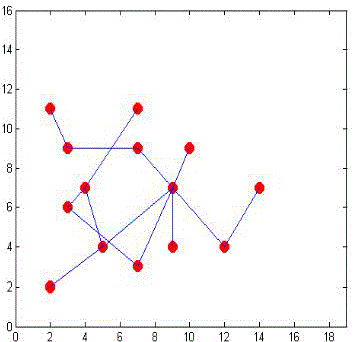 |
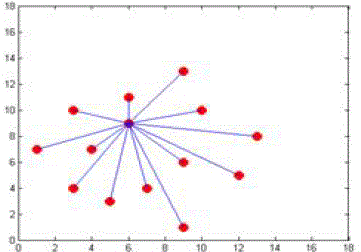 |
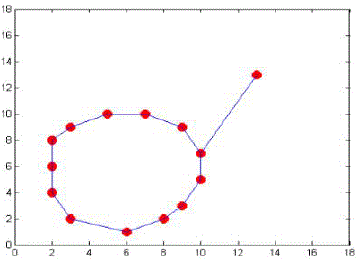 |
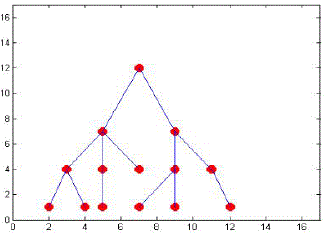 |
| Figure 1 |
Figure 2 |
Figure 3 |
Figure 4 |
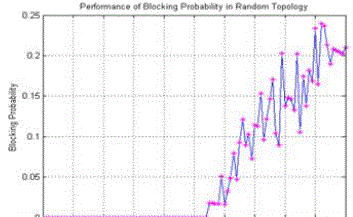 |
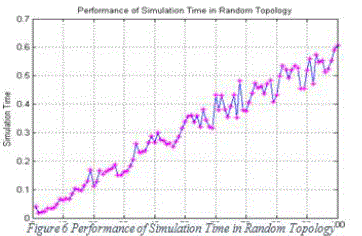 |
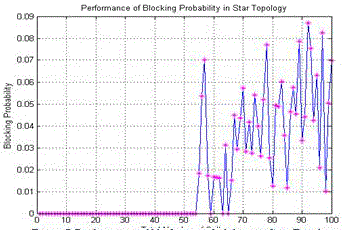 |
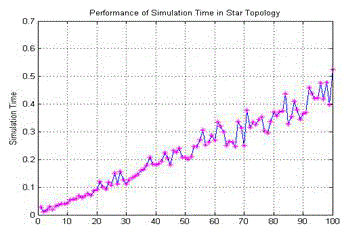 |
| Figure 5 |
Figure 6 |
Figure 7 |
Figure 8 |
|
References |
- A Fast Path-Based ILP Formulation for Offline RWA in Mesh Optical Networks Zeyu Liu, George N. Rouskas Department of Computer Science, North Carolina State University, Raleigh, NC 27695-8206, USA
- Performance analysis of topologies for optical wavelength convertible networks Chunyong Yang Shaoping Chen College of Electronics Information Engineering, South-Central University for Nationalities, Wuhan 430074, China
- Blocking in wavelength-routedall-opticalWDM networks AmitWason,R.S.KalerElectronics &CommunicationEngineeringDepartment,ThaparUniversity,Patiala,Punjab,IndiaReceived June2008;accepted30September2008
- Randhawa, Rajneesh; Kaler, R. S.; Singal, Anuj, Performance evaluation of algorithms for wavelength assignment in optical ring network , Optik -International Journal for Light and Electron Optics, vol. 124, issue 1, pp. 78-81
- Virtual topology reconfiguration in IP/WDM optical ring networks G. Mohan*, P.H.H. Ernest, V. Bharadwaj Department of Electrical and Computer Engineering, National University of Singapore, Singapore, Singapore Received 27 November 2001; revised 18 March 2002; accepted 27 March 2002
- HUI ZANG, JASON P. JUE, BISWANATH MUKHERJEE, Review of Routing and Wavelength Assignment Approaches for Wavelength-Routed Optical WDM Networks, 2000 SPIE/Baltzer Science Publishers 1388 6916/2000
- Xuehong Sun', Yunheo Lit, IoannisLambadarist and Yiqiang Q. Zhao?, Performance Analysis of First-Fit wavelength Assignment Algorithm in Optical Networks, 7th International Conference on Telecommunications - ConTEL 2003 ISBN: 953-184-0524. June 11-13,2003,Z agreb, Croatia
- Topology analysis of auto load-balancing RWA in optical burst-switched networks 15-16 April 2011 12048207 IEEE
|